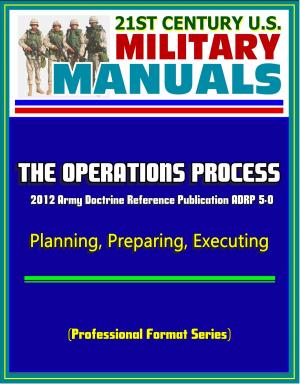A U.S. Air Force Strategy for Africa: Airpower, Geography, Current Activities and Guidance, What Can Airmen Expect in Africa, How Should Airmen Think About Africa?
Nonfiction, History, Africa, South Africa, Military, Aviation| Author: | Progressive Management | ISBN: | 9781310032912 |
| Publisher: | Progressive Management | Publication: | May 8, 2015 |
| Imprint: | Smashwords Edition | Language: | English |
| Author: | Progressive Management |
| ISBN: | 9781310032912 |
| Publisher: | Progressive Management |
| Publication: | May 8, 2015 |
| Imprint: | Smashwords Edition |
| Language: | English |
Professionally converted for accurate flowing-text e-book format reproduction, this military study examines flight operations in Africa for the U.S. Air Force. With the creation of United States Africa Command and the resurrection of Seventeenth Air Force, some Airmen responded with trepidation. The African continent seemed truly unknown territory, and many believed that the United States had little prior experience conducting flight operations in the region. But as Maj Paul F. Spaven points out, such concerns are largely groundless. Airmen have been operating in Africa for decades, and rich possibilities exist for crafting an air strategy to serve US interests in the region. This groundbreaking study offers a thorough analysis of the context for USAF strategy making in Africa, followed by a synthesis of what that strategy might look like. The analysis occurs in three chapters, covering the geography of Africa, the complex and varied history of US- and European-air operations in the region, and current US activities and strategic guidance pertaining to Africa. The synthesis occurs in three chapters, covering the conditions the USAF can expect to encounter in Africa, a discussion of how Airmen should think about the area of responsibility, and an examination of the ends, ways, and means of a proposed African strategy. The study concludes that a viable Air Force strategy in Africa is properly based on modest "ends" that reflect US national interests on the continent that are themselves limited in scope. These modest ends require that correspondingly limited "ways" and "means" be applied in order for the entire Air Force approach to remain balanced. The ways should focus on missions that create conditions for African states to solve their own security issues, thereby increasing their legitimacy. The means should focus on building the capacity for long-term operations in Africa with access to airfields, a force structure that includes strike and transport aircraft specialized for the region, an Air Force organization tailored to the peculiar demands of the continent, and specialized cultural training for Airmen. Spaven concludes that "only by accepting the risk of stepping beyond tactical and operational thinking can the Air Force do great things for the poorest of continents."
CHAPTER 1 - THE GEOGRAPHY OF AFRICA * Notes * CHAPTER 2 - AIRPOWER IN AFRICA: LESSONS FROM THE PAST * Notes * CHAPTER 3 - CURRENT US ACTIVITIES AND GUIDANCE * Notes * CHAPTER 4 - WHAT CAN AIRMEN EXPECT IN AFRICA? * Notes * CHAPTER 5 - HOW SHOULD AIRMEN THINK ABOUT AFRICA? * Notes * CHAPTER 6 - CONCLUSION: A US AIR FORCE STRATEGY FOR AFRICA
Professionally converted for accurate flowing-text e-book format reproduction, this military study examines flight operations in Africa for the U.S. Air Force. With the creation of United States Africa Command and the resurrection of Seventeenth Air Force, some Airmen responded with trepidation. The African continent seemed truly unknown territory, and many believed that the United States had little prior experience conducting flight operations in the region. But as Maj Paul F. Spaven points out, such concerns are largely groundless. Airmen have been operating in Africa for decades, and rich possibilities exist for crafting an air strategy to serve US interests in the region. This groundbreaking study offers a thorough analysis of the context for USAF strategy making in Africa, followed by a synthesis of what that strategy might look like. The analysis occurs in three chapters, covering the geography of Africa, the complex and varied history of US- and European-air operations in the region, and current US activities and strategic guidance pertaining to Africa. The synthesis occurs in three chapters, covering the conditions the USAF can expect to encounter in Africa, a discussion of how Airmen should think about the area of responsibility, and an examination of the ends, ways, and means of a proposed African strategy. The study concludes that a viable Air Force strategy in Africa is properly based on modest "ends" that reflect US national interests on the continent that are themselves limited in scope. These modest ends require that correspondingly limited "ways" and "means" be applied in order for the entire Air Force approach to remain balanced. The ways should focus on missions that create conditions for African states to solve their own security issues, thereby increasing their legitimacy. The means should focus on building the capacity for long-term operations in Africa with access to airfields, a force structure that includes strike and transport aircraft specialized for the region, an Air Force organization tailored to the peculiar demands of the continent, and specialized cultural training for Airmen. Spaven concludes that "only by accepting the risk of stepping beyond tactical and operational thinking can the Air Force do great things for the poorest of continents."
CHAPTER 1 - THE GEOGRAPHY OF AFRICA * Notes * CHAPTER 2 - AIRPOWER IN AFRICA: LESSONS FROM THE PAST * Notes * CHAPTER 3 - CURRENT US ACTIVITIES AND GUIDANCE * Notes * CHAPTER 4 - WHAT CAN AIRMEN EXPECT IN AFRICA? * Notes * CHAPTER 5 - HOW SHOULD AIRMEN THINK ABOUT AFRICA? * Notes * CHAPTER 6 - CONCLUSION: A US AIR FORCE STRATEGY FOR AFRICA















